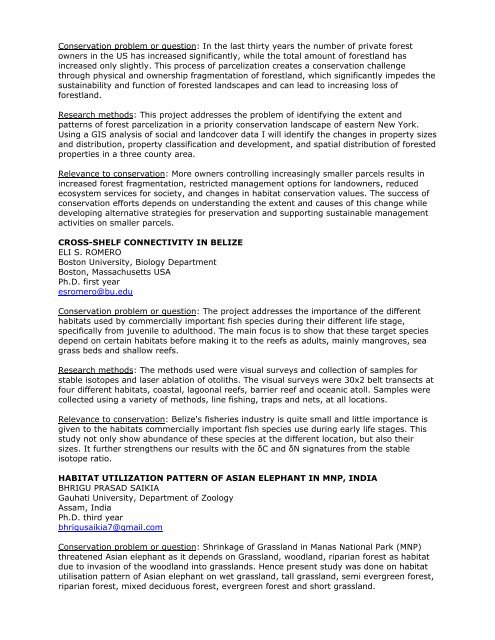Poster Abstracts in Word 29oct - American Museum of Natural History
Poster Abstracts in Word 29oct - American Museum of Natural History
Poster Abstracts in Word 29oct - American Museum of Natural History
Create successful ePaper yourself
Turn your PDF publications into a flip-book with our unique Google optimized e-Paper software.
Conservation problem or question: In the last thirty years the number <strong>of</strong> private forestowners <strong>in</strong> the US has <strong>in</strong>creased significantly, while the total amount <strong>of</strong> forestland has<strong>in</strong>creased only slightly. This process <strong>of</strong> parcelization creates a conservation challengethrough physical and ownership fragmentation <strong>of</strong> forestland, which significantly impedes thesusta<strong>in</strong>ability and function <strong>of</strong> forested landscapes and can lead to <strong>in</strong>creas<strong>in</strong>g loss <strong>of</strong>forestland.Research methods: This project addresses the problem <strong>of</strong> identify<strong>in</strong>g the extent andpatterns <strong>of</strong> forest parcelization <strong>in</strong> a priority conservation landscape <strong>of</strong> eastern New York.Us<strong>in</strong>g a GIS analysis <strong>of</strong> social and landcover data I will identify the changes <strong>in</strong> property sizesand distribution, property classification and development, and spatial distribution <strong>of</strong> forestedproperties <strong>in</strong> a three county area.Relevance to conservation: More owners controll<strong>in</strong>g <strong>in</strong>creas<strong>in</strong>gly smaller parcels results <strong>in</strong><strong>in</strong>creased forest fragmentation, restricted management options for landowners, reducedecosystem services for society, and changes <strong>in</strong> habitat conservation values. The success <strong>of</strong>conservation efforts depends on understand<strong>in</strong>g the extent and causes <strong>of</strong> this change whiledevelop<strong>in</strong>g alternative strategies for preservation and support<strong>in</strong>g susta<strong>in</strong>able managementactivities on smaller parcels.CROSS-SHELF CONNECTIVITY IN BELIZEELI S. ROMEROBoston University, Biology DepartmentBoston, Massachusetts USAPh.D. first yearesromero@bu.eduConservation problem or question: The project addresses the importance <strong>of</strong> the differenthabitats used by commercially important fish species dur<strong>in</strong>g their different life stage,specifically from juvenile to adulthood. The ma<strong>in</strong> focus is to show that these target speciesdepend on certa<strong>in</strong> habitats before mak<strong>in</strong>g it to the reefs as adults, ma<strong>in</strong>ly mangroves, seagrass beds and shallow reefs.Research methods: The methods used were visual surveys and collection <strong>of</strong> samples forstable isotopes and laser ablation <strong>of</strong> otoliths. The visual surveys were 30x2 belt transects atfour different habitats, coastal, lagoonal reefs, barrier reef and oceanic atoll. Samples werecollected us<strong>in</strong>g a variety <strong>of</strong> methods, l<strong>in</strong>e fish<strong>in</strong>g, traps and nets, at all locations.Relevance to conservation: Belize's fisheries <strong>in</strong>dustry is quite small and little importance isgiven to the habitats commercially important fish species use dur<strong>in</strong>g early life stages. Thisstudy not only show abundance <strong>of</strong> these species at the different location, but also theirsizes. It further strengthens our results with the δC and δN signatures from the stableisotope ratio.HABITAT UTILIZATION PATTERN OF ASIAN ELEPHANT IN MNP, INDIABHRIGU PRASAD SAIKIAGauhati University, Department <strong>of</strong> ZoologyAssam, IndiaPh.D. third yearbhrigusaikia7@gmail.comConservation problem or question: Shr<strong>in</strong>kage <strong>of</strong> Grassland <strong>in</strong> Manas National Park (MNP)threatened Asian elephant as it depends on Grassland, woodland, riparian forest as habitatdue to <strong>in</strong>vasion <strong>of</strong> the woodland <strong>in</strong>to grasslands. Hence present study was done on habitatutilisation pattern <strong>of</strong> Asian elephant on wet grassland, tall grassland, semi evergreen forest,riparian forest, mixed deciduous forest, evergreen forest and short grassland.
















